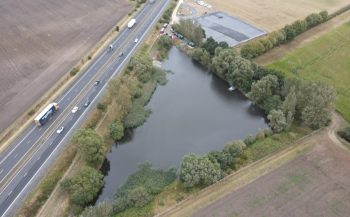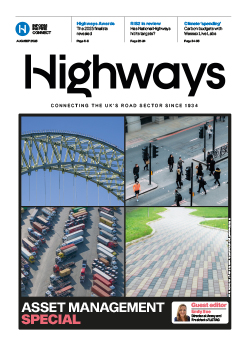Steve Jackson of Soilfix Ltd and Tom Wilson of Carnell Group report on the innovative restoration of a major highways stormwater lagoon.
Carnell engaged Soilfix to remediate a stormwater balancing lagoon called Twigmoor Pond (pictured below) on the M180, near Scunthorpe, under its maintenance framework with National Highways.
An accumulation of silt in the lagoon over the 20-plus years since its construction had created a flood risk to both adjacent farmland and the motorway.
Pre-planning and feasibility trials were carried out between April and July 2024, and the project was executed between August and October. Investigations by Soilfix identified 200mm to 800mm of silt across the area of the lagoon (7,000 square metres).
Testing of the silt confirmed that, once removed, it would be classified as hazardous waste, requiring off site disposal due to elevated concentrations of both fuel and oil-based hydrocarbons. However, by the end of the scheme an innovative approach had treated 2,000 tonnes of hazardous material in situ to save money and improve environmental outcomes.
Three ‘SoilTan’ silt bags, each the size of four tennis courts, captured and remediated contaminated highway sediments for efficient disposal.
Removal of the silt presented several logistical and technical challenges:
- Access limitations: Reaching remote areas of the lagoon with conventional plant was potentially unfeasible.
- Environmental considerations: Minimising disturbances to vegetation and wildlife surrounding the lagoon was paramount.
- Land use constraints: Access via adjoining agricultural land introduced further complexities.
- Moisture management: Reducing the silt’s moisture content was critical for minimising the volume, facilitating transportation and the acceptance of the material for sustainable treatment off site without incurring a significant landfill tax burden.
Remediation options
An appraisal of remediation options identified the ‘best available techniques’ for achieving the objectives and KPIs.
Draining the lagoon and removing the silt with conventional plant presented substantial challenges, including managing large volumes of contaminated stormwater and temporarily removing infrastructure from viable service.
It also reduced the potential to retain reed and wetland habitats around the banks of the lagoon and would result in greater volumes of problematic ‘wet’ silt being removed off site. Direct pumping of the silt using a mobile silt pump attached to an amphibious ‘Truxor’ dredging boat was determined as the optimal method to remove it.
It was recognised that this would reduce the quantity of recoverable silt but it was calculated that a reduction of more than 60% in the quantum of basal silt would return the lagoon to the required capacity.
The next challenge was to sufficiently dry the silt to enable conventional tipper transport from site rather than using tankers. This would also significantly reduce the total tonnage of hazardous waste and enable more sustainable bio-treatment at a permitted facility for landfill restoration at zero rate of landfill tax. Amendments including quicklime and proprietary drying products were considered but discounted due to both the cost and the potential to increase the hazardous properties of the waste, making off site treatment harder.
Centrifuge and belt press processing plant were also discounted due to access restrictions and the speed of processing.
Geotextile silt bags, assessed using an intermediate bulk container-based field trial, were confirmed as the best available technique to achieve the silt dewatering.
Three high quality SoilTan silt bags, measuring 14 by 65 metres, were obtained from Huesker. These comprise a geotextile container made of a filter fabric – used to dewater a wide variety of sludge types.
The solids in the sludge are retained by the specially developed high-performance filter fabric, allowing the water to drain away under hydraulic back-pressure.
Soilfix and Carnell constructed a geomembrane-lined treatment cell for operating the three silt bags and ensuring no cross-contamination of underlying arable farmland. This was engineered to a low point or sump where the water was drained from the silt bags and could be pumped back to the lagoon under a temporary consent agreed with the Environment Agency.
Before dewatering in the silt bags, an intermediate silt removal stage was established comprising a settlement tank and lamella clarifier. The objective was to remove any silt and other oversize material (e.g. organics) prior to further treatment, increasing available capacity.
The works were completed in 12 weeks, achieving the objective of greater than 60% silt removal with zero lost-time incidents. Almost 2,000 tonnes of hazardous classified ‘wet’ silt was diverted from landfill and the capacity of the lagoon was fully restored with minimal impacts on wildlife.






